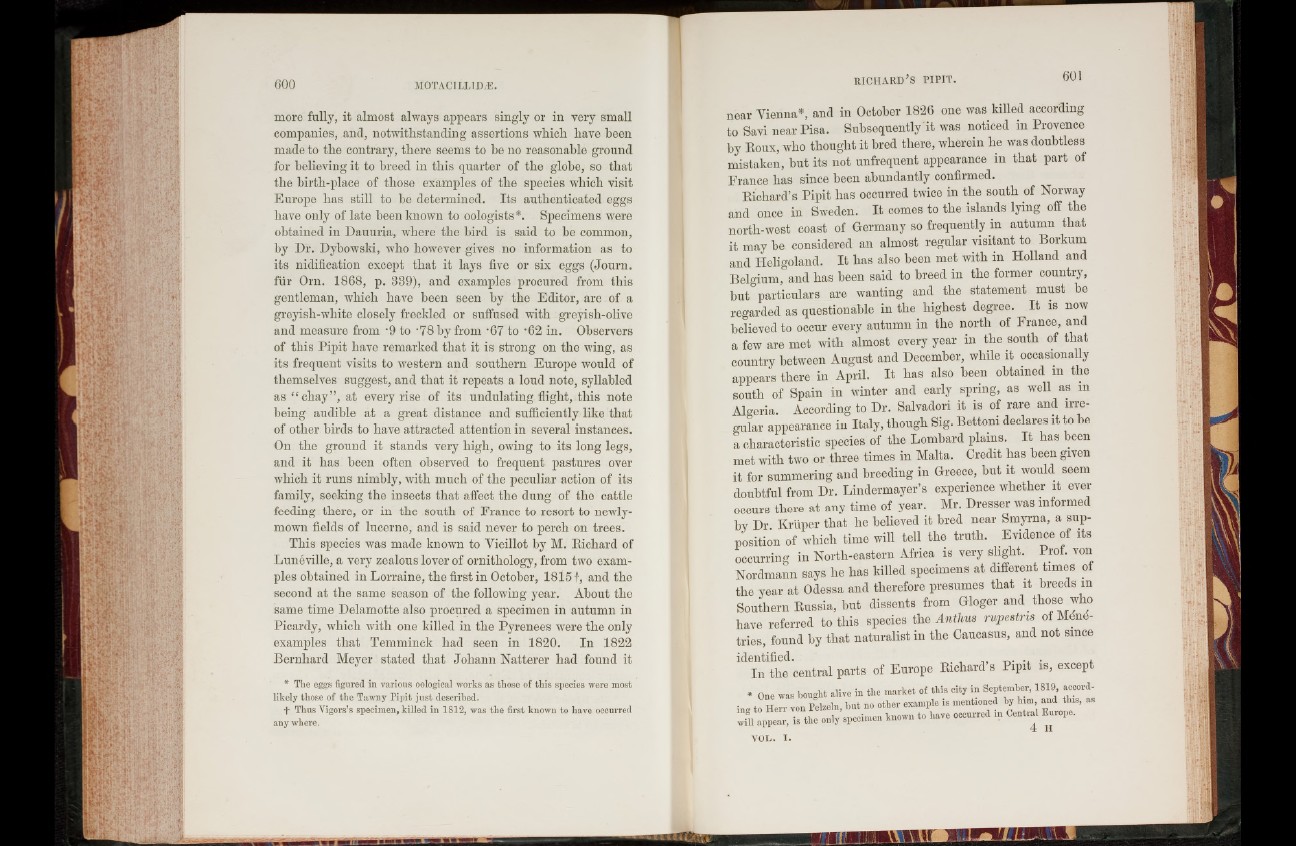
more fully, it almost always appears singly or in very small
companies, ancl, notwithstanding assertions which have been
made to the contrary, there seems to be no reasonable ground
for believing it to breed in this quarter of the globe, so that
the birth-place of those examples of the species which visit
Europe has still to be determined. Its authenticated eggs
have only of late been known to oologists*. Specimens were
obtained in Dauuria, where the bird is said to be common,
by Dr. Dybowski, who however gives 110 information as to
its nidification except that it lays live or six eggs (Journ.
fur Orn. 1868, p. 339), and examples procured from this
gentleman, which have been seen by the Editor, are of a
greyish-white closely freckled or suffused with greyish-olive
and measure from '9 to '78 by from -67 to -62 in. Observers
of this Pipit have remarked that it is strong on the wing, as
its frequent visits to western and southern Europe would of
themselves suggest, and that it repeats a loud note, syllabled
as “ chay”, at every rise of its undulating flight, this note
being audible at a great distance and sufficiently like that
of other birds to have attracted attention in several instances.
On the ground it stands very high, owing to its long legs,
and it has been often observed to frequent pastures over
which it runs nimbly, with much of the peculiar action of its
family, seeking the insects that affect the dung of the cattle
feeding there, or in the south of France to resort to newly-
mown fields of lucerne, and is said never to perch on trees.
This species was made known to Yieillot by M. Richard of
Luneville, a very zealous lover of ornithology, from two examples
obtained in Lorraine, the first in October, 1815 f, and the
second at the same season of the following year. About the
same time Delamotte also procured a specimen in autumn in
Picardy, which with one killed in the Pyrenees were the only
examples that Temminck had seen in 1820. In 1822
Bernhard Meyer stated that Johann Natterer had found it
* The eggs figured in various oological works as those of this species were most
likely those of the Tawny Pipit just described.
f Thus Vigors’s specimen, killed in 1812, was the first known to have occurred
any where.
near Vienna*, and in October 1826 one was killed according
to Savi near Pisa. Subsequently it was noticed in Provence
by Roux, who thought it bred there, wherein he was doubtless
mistaken, hut its not unfrequent appearance in that part of
France has since been abundantly confirmed.
Richard’s Pipit has occurred twice in the south of Norway
and once in Sweden. I t comes to the islands lying off the
north-west coast of Germany so frequently in autumn that
it may he considered an almost regular visitant to Borkum
and Heligoland. I t has also been met with in Holland and
Belgium, and has been said to breed in the former country,
hut particulars are wanting and the statement must he
regarded as questionable in the highest degree. I t is now
believed to occur every autumn in the north of France, and
a few are met with almost every year in the south of that
country between August and December, while it occasionally
appears there in April. I t has also been obtained m the
south of Spain in winter and early spring, as well as in
Algeria. According to Dr. Salvadori it is of rare and ine-
gular appearance in Italy, though Sig. Bottom declares it to he
a characteristic species of the Lombard plains. I t has been
met with two or three times in Malta. Credit has been given
it for summering and breeding in Greece, but it would seem
doubtful from Dr. Lindermayer’s experience whether it ever
occurs there at any time of year. Mr. Dresser was informed
by Dr. Kriiper that he believed it bred near Smyrna, a supposition
of which time will tell the truth. Evidence of its
occurring in North-eastern Africa is very slight. Prof. von
Nordmann says he has killed specimens at different times of
the year at Odessa and therefore presumes that it breeds in
Southern Russia, but dissents from Gloger and those who
have referred to this species the Anthus rupestns of Mend-
tries, found by that naturalist in the Caucasus, and not since
identified. , „ •. ■ +
In the central parts of Europe Richard s Pipit is, except
* One was bought alive in tlie market of this city in September, 1819, according
to Herr von re ta in , but no other example is mentioned by him and this, as
will appear, is the only specimen known to have occurred m Central Europe.
VOL. I .